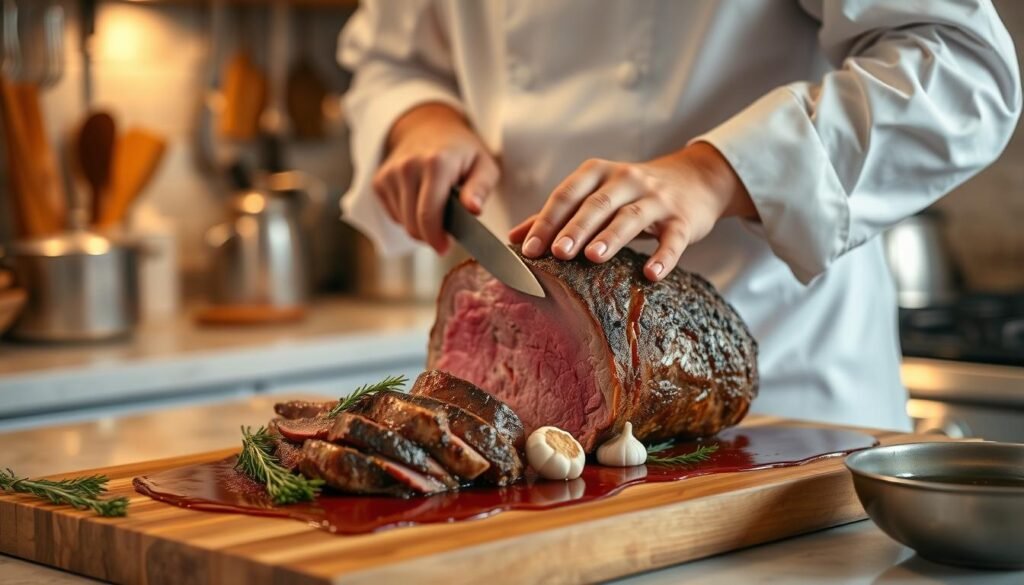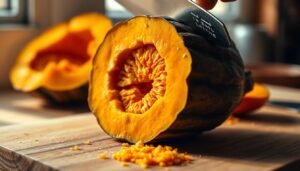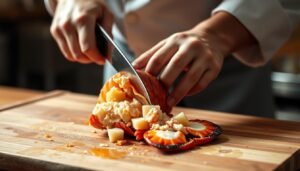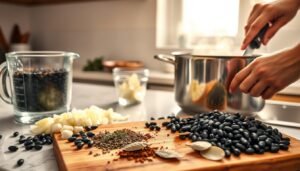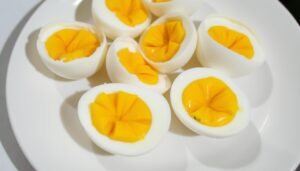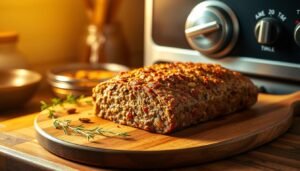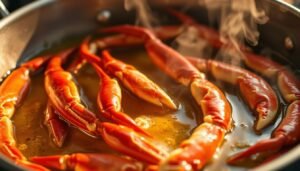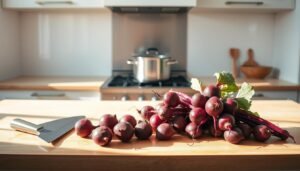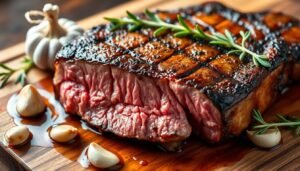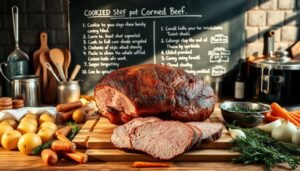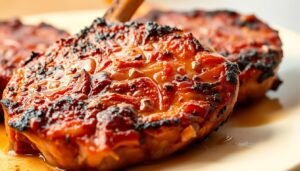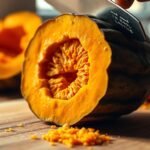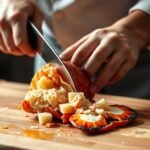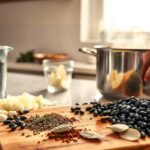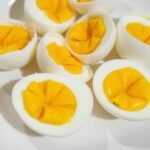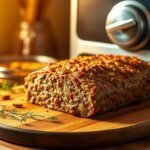Did you know that around 32% of Americans love prime rib for holiday meals? This fact shows how popular this tender beef is. It also shows how much people want to learn how to cook it perfectly. In this guide, I’ll share all you need to know about cooking prime rib. You’ll impress everyone with a delicious dish every time.
Whether you’re looking for the best prime rib recipe or how to get it just right, you’re in the right place. Let’s start your tasty journey together.
Key Takeaways
- Prime rib is a holiday favorite for many Americans.
- Understanding the types of cuts is essential for selecting the right prime rib.
- Essential tools, including a thermometer, are crucial for successful cooking.
- Preparation methods can greatly affect the flavor and juiciness of the meat.
- Learning common mistakes can help improve your prime rib skills.
- Creative cooking methods like sous vide can elevate your dish.
Understanding Prime Rib and Its Cuts
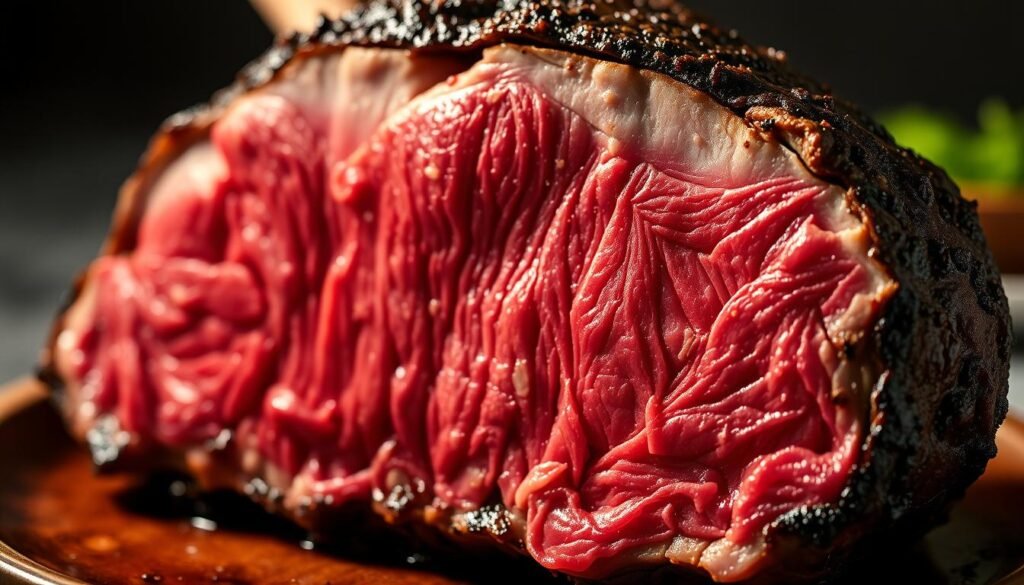
Prime rib is a luxurious cut of beef from the rib primal of the cow. This section will explore the prime rib definition, various cuts of prime rib, and tips for choosing prime rib to enhance your culinary experience.
What is Prime Rib?
Prime rib is a tender and flavorful cut of beef. It includes several ribs, from 6 to 12, and can be served bone-in or boneless. Bone-in prime rib has a deeper flavor, thanks to the bone.
Different Cuts of Prime Rib
Knowing the different cuts of prime rib is key for cooking and enjoying. Here are the main cuts:
| Cut | Description | Best for |
|---|---|---|
| Bone-in Ribeye | Rich flavor and tenderness, provides marrow-rich juices. | Grilling or roasting |
| Boneless Rib Roast | Easy to carve, with a balance of flavor and tenderness. | Elegant presentations or special occasions |
| Standing Rib Roast | Holds the bones upright, allowing for even cooking and beautiful presentation. | Festive dinners or gatherings |
Selecting the Best Cut at the Store
When choosing prime rib, aim for about 1 pound per person for a meal. For bigger gatherings, adjust to ½ to ¾ pound per guest. This ensures everyone gets enough, even with side dishes. Always check with your butcher about weight and bone-in needs before buying. This helps pick the perfect cut for a memorable meal.
Essential Tools and Equipment for Cooking
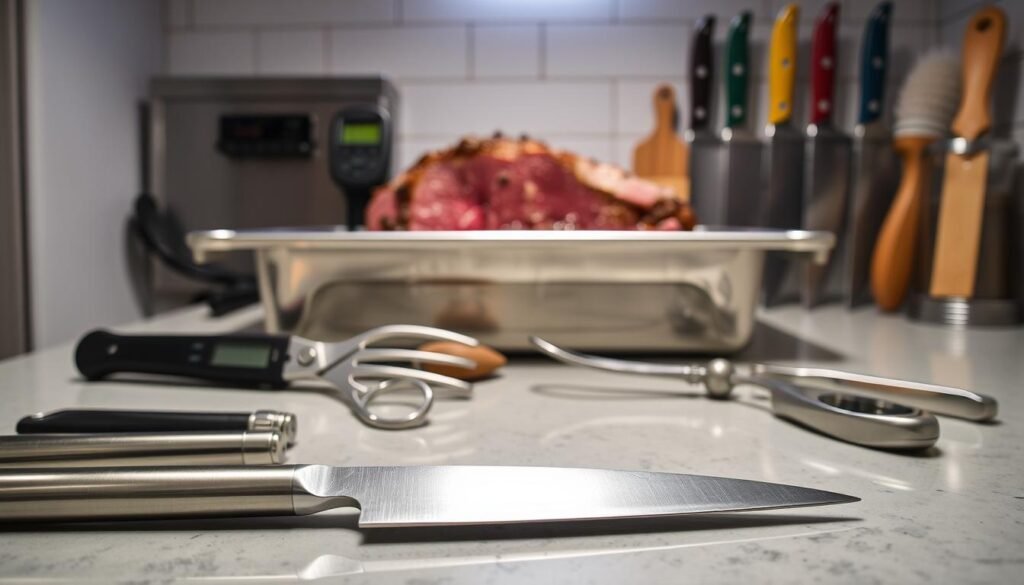
Cooking prime rib needs skill and the right kitchen equipment. The right cooking tools for prime rib make a big difference. Let’s look at the must-have items for this delicious meat.
Kitchen Tools You Will Need
First, get a sharp carving knife and a strong cutting board. These help you cut the meat easily, making clean slices. Also, a roasting pan that fits your prime rib is key for even cooking.
- Sharp carving knife
- Sturdy cutting board
- Roasting pan
- Kitchen twine
- Aluminum foil
Recommended Cooking Equipment
Use a cast iron skillet to sear the meat before roasting. This method keeps flavors in and makes a great crust. Racks help by letting the meat cook evenly, thanks to better heat flow.
Importance of a Meat Thermometer
A quality meat thermometer is crucial. The meat thermometer significance is huge. It removes the guesswork, ensuring your prime rib is cooked just right. I recommend a probe or instant-read thermometer for the best results.
| Tool | Purpose |
|---|---|
| Carving Knife | Slicing meat cleanly |
| Cutting Board | Stable surface for preparation |
| Roasting Pan | Even cooking of prime rib |
| Cast Iron Skillet | For searing the meat |
| Meat Thermometer | Ensure perfect doneness |
Preparing Your Prime Rib
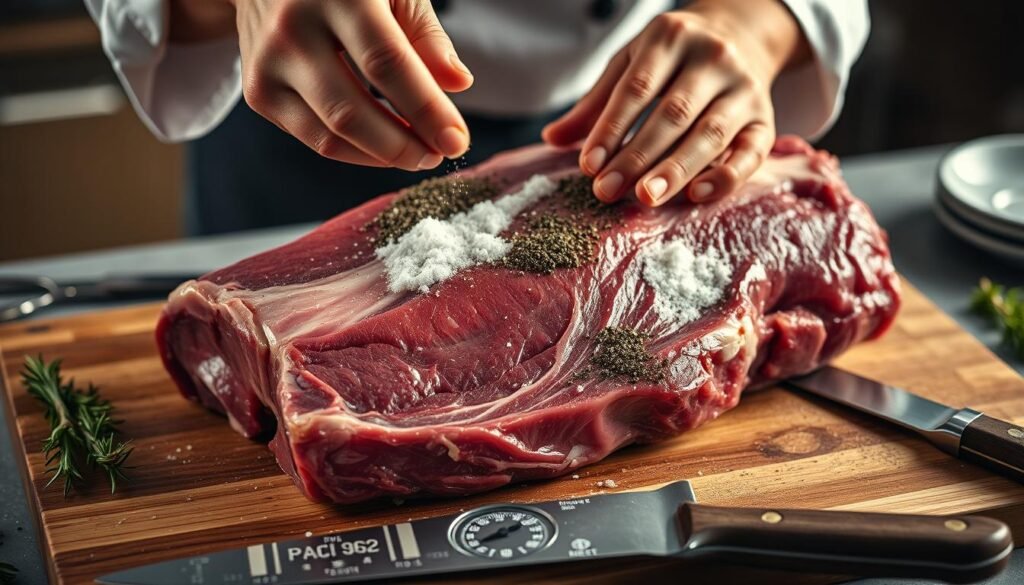
Understanding the aging and seasoning of prime rib can make a big difference. You have to choose between dry aging and wet aging. Each method affects the meat’s flavor and tenderness. Let’s look at these processes and how to season and prepare your prime rib for roasting.
Dry Aging vs. Wet Aging
Dry aging hangs the prime rib in a controlled space. This process lets moisture evaporate, making the meat taste richer and firmer. It takes weeks, but the flavor is worth it. Wet aging, on the other hand, seals the meat in bags to keep it moist and tender. It’s faster, lasting just days, but might not have the same flavor as dry aging.
Seasoning Options for Prime Rib
Seasoning prime rib is best kept simple. A mix of salt, pepper, and herbs or garlic can enhance its taste. Seasoning right after it comes out of the fridge helps the flavors soak in better. Adding olive oil can also help herbs stick to the meat.
Preparing the Meat for Roasting
Before roasting, let the prime rib come to room temperature. This ensures it cooks evenly. Taking it out of the fridge 1-2 hours before cooking is ideal. Once seasoned and at room temperature, it’s ready for the oven or grill, making it a delicious centerpiece.
Cooking Methods for Prime Rib
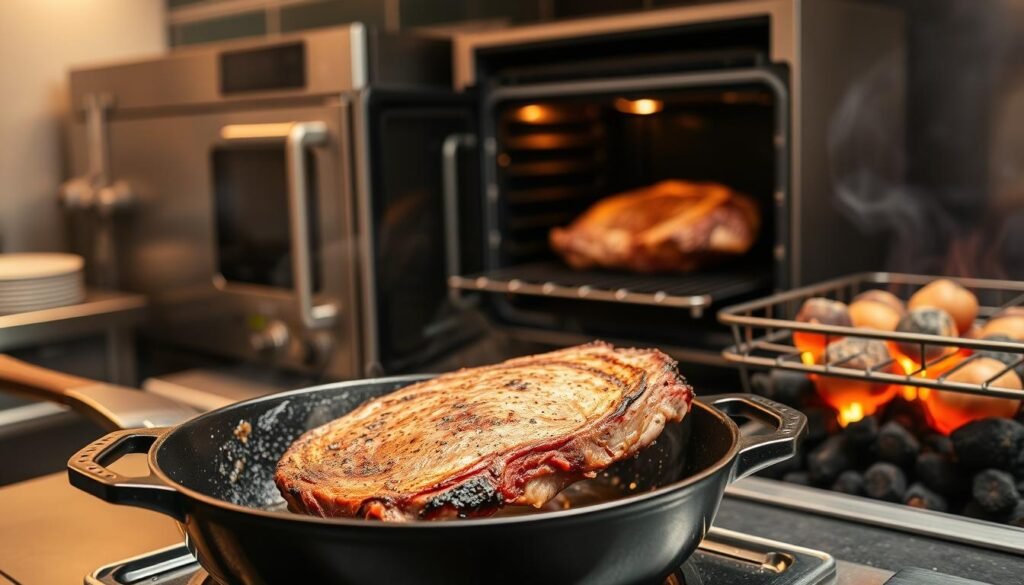
The world of cooking prime rib is vast, with each method adding its own twist. Oven roasting is my top choice for its delicious crust. Grilling adds a smoky taste, while sous vide ensures perfect doneness every time. Let’s explore these methods and my experiences with them.
Oven Roasting Prime Rib
Oven roasting starts with a high oven temperature. I preheat to 500°F for 15 minutes to get a great crust. Then, I lower it to 325°F and cook until it’s just right. This method keeps the meat juicy and flavorful.
Grilling Techniques for Prime Rib
Grilling prime rib brings a smoky flavor that many love. I use two-zone grilling for a sear and then slow cooking. This method gives the meat a perfect texture and taste without drying it out.
Sous Vide Cooking for Perfect Doneness
Sous vide has changed how I cook prime rib. By sealing the meat and cooking it in water, I avoid overcooking. A quick sear afterwards adds a beautiful crust to the juicy inside.
| Cooking Method | Flavor Profile | Ideal Internal Temperature | Cooking Time |
|---|---|---|---|
| Oven Roasting | Crispy crust, tender interior | Rare: 125°F, Medium: 135°F | Varies by size |
| Grilling | Smoky flavor, charred exterior | Rare: 125°F, Medium: 135°F | Varies by size |
| Sous Vide | Juicy, evenly cooked | Rare: 125°F, Medium: 135°F | 8-24 hours, depending on thickness |
Achieving the Perfect Cook
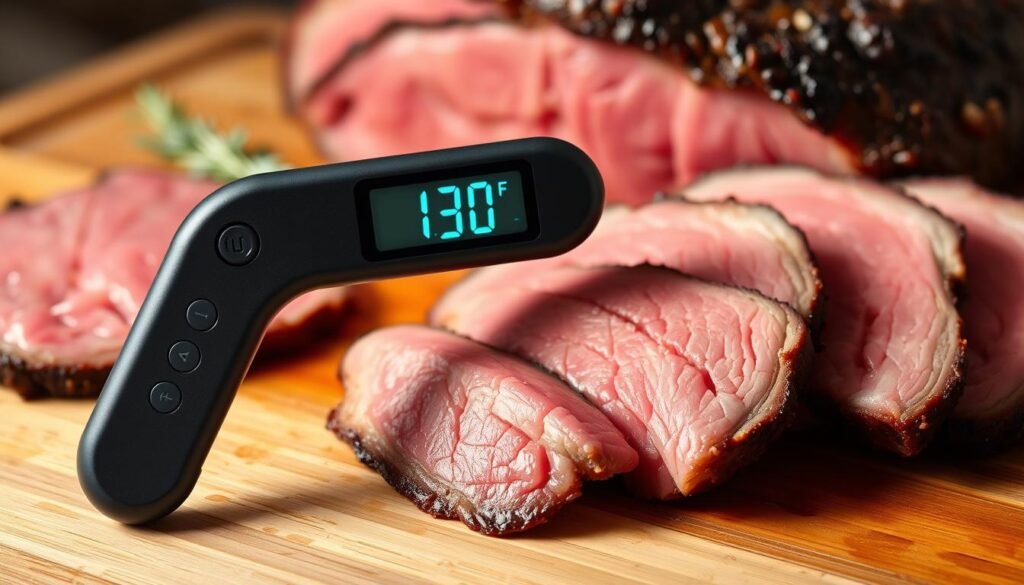
Knowing the perfect internal temperature is key when cooking prime rib. Each doneness level has its own temperature target. For rare, aim for 115-120°F. Medium-rare is 125-130°F, and medium is 135-140°F.
Keeping an eye on these temperatures ensures the prime rib stays juicy and flavorful.
Understanding Internal Temperature
A meat thermometer is your best friend for the perfect cook. It removes the guesswork and ensures each slice is at the right temperature. The precision in temperature control makes a big difference in your prime rib experience.
Resting Your Meat After Cooking
After reaching the desired temperature, let the prime rib rest for at least 30 minutes. This step helps juices spread evenly, keeping the meat moist. The temperature may rise a bit, making it even more tender.
How to Slice Prime Rib for Servings
Slicing prime rib requires the right technique. Always slice against the grain. This makes the meat tender and each bite enjoyable. It also shows off the meat’s layers.
To learn more about the perfect process, check out this detailed guide on prime rib preparation.
Delicious Prime Rib Recipes
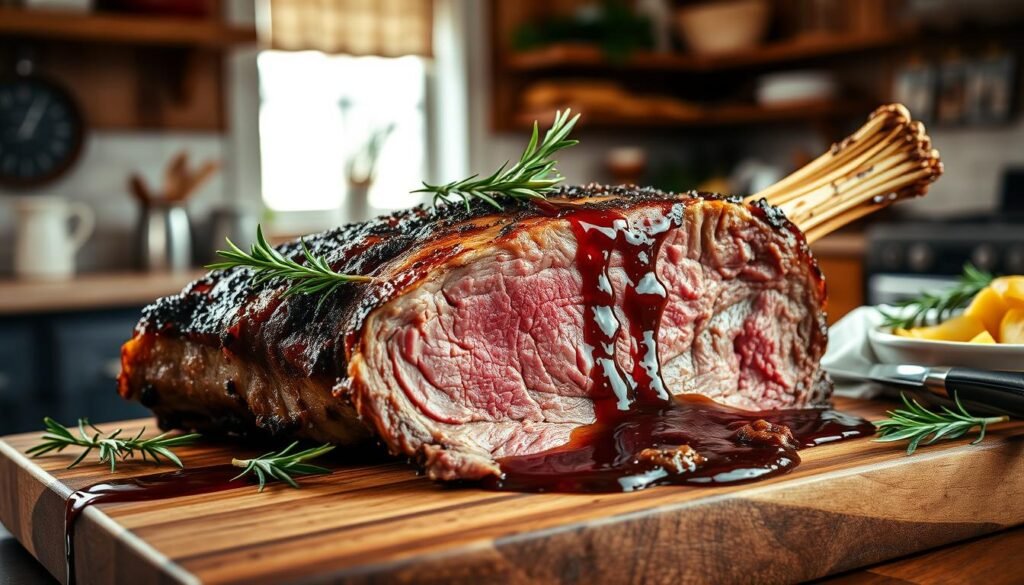
Prime rib recipes blend creativity with tradition. Trying new flavors can make this classic dish truly special. Here are three tasty recipes that show how versatile prime rib can be, making every meal flavorful.
Classic Herb-Crusted Prime Rib
The herb-crusted prime rib is a timeless choice. I mix fresh herbs like rosemary and thyme with salt and pepper for the crust. This creates a stunning look and a delicious taste. The classic herb-crusted prime rib is ideal for any special event.
Garlic Butter Prime Rib Recipe
The garlic butter prime rib adds a rich layer of flavor. I make seasoned butter with garlic and herbs, which boosts the meat’s taste as it cooks. This makes the meat juicy and full of flavor.
Braised Prime Rib with Red Wine Sauce
Braising prime rib in red wine sauce adds depth and complexity. The wine enhances the meat’s natural flavor, making it succulent. Each slice, served with the rich sauce, is a highlight of any meal.
Serving Suggestions for Prime Rib
When I think about serving prime rib, it’s more than just the meat. It’s about making a complete meal that delights everyone. The right side dishes can really make a difference. They should add to the meal without taking over.
Ideal Side Dishes for Prime Rib
Classic side dishes can take prime rib to the next level. Here are some great options:
- Mashed potatoes: Creamy and buttery.
- Roasted vegetables: Such as carrots and Brussels sprouts.
- Yorkshire pudding: A traditional favorite.
- Creamed spinach: Adds a decadent touch.
- Caesar salad: A crisp, refreshing balance.
Wine Pairings to Elevate Your Meal
Perfect wine pairings are key to a great meal. Try these:
| Wine Type | Tasting Notes |
|---|---|
| Cabernet Sauvignon | Full-bodied with notes of dark fruit and oak. |
| Merlot | Smoother profile with hints of plum and chocolate. |
| Malbec | Rich with fruity flavors, complements the meat’s richness. |
How to Present Your Prime Rib
The way I present my prime rib is important. I serve it on a large, elegant platter with fresh herbs like rosemary or thyme. This makes the prime rib the star of the show. For more tips, check out this resource.
Common Mistakes to Avoid
When cooking prime rib, some mistakes cooking prime rib can ruin a great dish. Knowing these common errors is key to getting a juicy and tasty prime rib.
Overcooking Your Prime Rib
One big mistake is overcooking the meat. It’s important to watch the internal temperature closely. For a perfect medium-rare, aim for 120 to 135°F. A good meat thermometer can help avoid overcooking.
Ignoring Meat Resting Time
Another common error is not letting the meat rest after cooking. It’s crucial to let it rest for at least 20 minutes. This helps keep the juices inside, making the roast more flavorful when you slice it.
Not Using Enough Seasoning
Seasoning is very important. Many home cooks don’t season their prime rib enough, making it taste bland. Use plenty of salt, pepper, and your favorite herbs to bring out the meat’s natural flavors. For more tips on seasoning, check out this article.
Storing Leftover Prime Rib
After enjoying a delicious prime rib dinner, the challenge often lies in properly storing the leftovers. Effective leftover prime rib storage is essential to maintaining the meat’s flavor and tenderness over the following days. To ensure optimal freshness, I recommend wrapping the leftover prime rib tightly in plastic wrap or placing it into an airtight container. This way, the meat can be safely stored in the refrigerator for up to 5 to 7 days and can even be frozen for up to 6 months.
When it comes to using prime rib leftovers creatively, the options are plentiful. I enjoy making hearty sandwiches, tossing bits of meat into salads for added protein, or mixing it into pasta dishes for a gourmet feel. The rich flavor of the prime rib enhances each dish, making my leftovers become a highlight of the week.
As I prepare to enjoy my leftovers, I follow some reheating tips to retain that delectable taste. Gently reheating in the oven or on the stovetop helps preserve the meat’s tenderness, while using the microwave may lead to dryness. For an added boost of moisture, I often drizzle a bit of leftover au jus over the prime rib before reheating. For further insights and techniques, you can check out this reheating guide. Exploring these practices allows me to savor delicious prime rib meals long after the initial feast.


